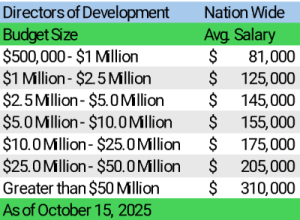“What should I pay my fundraiser?” is one of the most common questions we are asked.
The simple answer is in the table below. The real answer is much more complex.
The Simple Answer

*Salary analysis based on combined data of Our Fundraising Search, Candid and Salary.com.
But it’s more complex than that.
The general rule of thumb is that, on average, it takes one full time equivalent employee (FTE) to raise $500,000 annually, so for every $1 Million an organization wants to raise, they should expect to require two FTEs. While there is a huge amount of variation in the range of FTEs it takes to raise $1 Million, this is a helpful perspective for nonprofit boards and CEOs. However, it immediately creates the question: “how much should I be paying my fundraiser?”
We first published “What is the Right Amount to Pay My Fundraiser?” in 2021, and, to date, it remains one of the most popular blog posts we have ever written. In fact, it is what led us to build a nonprofit compensation practice. In this post, we go into great detail on how we build the compensation model. (If you haven’t read it already, click through. We’ll wait.)
While the information and guidance in our first post is still accurate, we are continually prompted to answer the follow up question: What are these numbers based on?
The accurate answer for your specific organization is a function of four things:
- The revenue budget of your organization. Said simply, how much do you expect the fundraiser to raise?
- The experience level you are hoping to recruit.
- Your nonprofit’s sector. (e.g., higher education, healthcare, etc.)
- The actual, geographic market where your nonprofit is located.
Let’s explore each of these separately.
The Impact of Budget Size
As you can see from the table above, budgets can increase the salary anywhere from 7% in the midrange to more than 50% at the top and bottom of the scale. These numbers are not hard to find. Any candidate with an organization’s 990 and access to salary.com can figure out what the general salary range for a specific organization should be. On average, each incremental budget category pushes up the target salary by 26%.
The Impact of Experience
The salaries above are average salaries, nationwide. While the average salary of a development director at a $2.5 Million nonprofit is $125,000, the range of salaries can vary from a low of $65,000 to a high exceeding $180,000.
Every so often we meet with a potential client who doesn’t want to spend more than the absolute minimum on a role. As a result, only the least experienced candidates apply. The client’s justification is usually “we want to hire at the bottom of the scale with the hope that the director will grow in the role.” Unfortunately, that approach only works when the executive director has a strong development background – most don’t – and can help train and mentor the fundraiser.
Said bluntly, you get what you pay for. Experienced candidates know what they are worth and aren’t going to work for less.
That being said, you may need to adjust your expectations according to what salary you can afford. With an investment in coaching, candidates with less experience, but possessing the right skillset, can be successful as well.
The Impact of Nonprofit Sector
The sector matters. Major healthcare systems, higher education, research institutions and large foundations or public trusts pay at the highest levels in the sector. Meanwhile, faith-based organizations, human services & social assistance, free & charitable clinics, and small arts & culture organizations tend to pay the lowest range. The variance between the highest and lowest sectors is often well over $100,000 for candidates with similar experience levels and organizations of similar budget sizes.
It is worth noting that research consistently shows that compensation is only weakly correlated to retention. A whole host of factors impact retention of your key fundraising roles. We discuss this at length in our recent blog “Tackling the Topic of Fundraiser Retention”.
The Impact of Geographic Location
This impact has two important subfactors: the local cost-of-living and the fundraising landscape. Most of us can wrap our heads around the cost-of-living aspect. For a two-parent, two-child family in San Francisco, the Economic Policy Institute estimates an annual budget of approximately $181,000 is required to maintain a modest standard of living, versus $84,000 for the same family living in Valdosta, Georgia. Salary ranges must contemplate this reality.
Geographic location also impacts local market conditions. The fewer nonprofits there are in a town, the fewer fundraisers that there are to recruit. In a college town, for example, where a major university is located and is the primary employer, that school will set the rate for fundraisers. They probably also employ most of the fundraisers, so you are not going to easily lure them away.
So, How Do I Find Out the Accurate Answer?
- In the simplest of terms, use the following formula as explained in “What is the Right Amount to Pay My Fundraiser?”:
- Determine what the revenue expectation is for the organization and set the CEO’s compensation structure using the expectation of 1.00% for the bottom of the range, 1.75% for the midpoint and 2.50% for the top of the range.
- For the senior development role, multiply those percentages by 85%. That means the compensation structure would be set 0.85% of revenue for the bottom of the range, 1.49% for the midpoint of the range, and 2.13% of revenue for the top of the range.
- For greater accuracy and to ensure you are as competitive as possible in this difficult market, allow us to conduct a salary study for you. This is a relatively quick and inexpensive service, and will contemplate all of the factors above. We subscribe to and consult multiple databases nationwide to advise client organizations on salary ranges for all roles.
The most important thing to remember is that mission and passion do not override the four factors above. If a client comes to us and says “I want to hire an experienced Development Director but I can’t pay more than $60,000” our response is “Then, you can’t afford an experienced development director.”
If your organization’s business model is dependent upon paying significantly below market for your employees, you are destined to have recruitment and retention problems. The problem is not the candidates; it’s your compensation model.






Leave A Comment